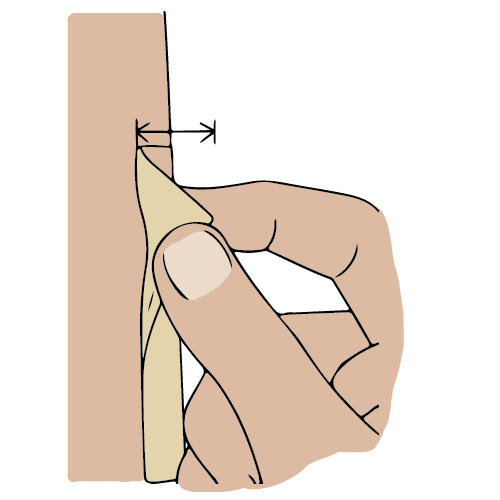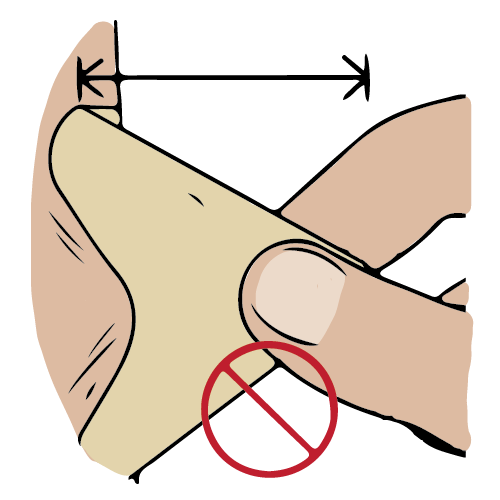All About Kinesiology Tape
Kinesiology tape, K tape, or elastic therapeutic tape can be seen splayed across athletes' shoulders, legs, arms, and joints in all kinds of sports. This super stretchy, flexible tape offers support, reduces pain and swelling, and doesn’t limit movement allowing the wearer to perform at their best.
In this article, we’ll cover the basics of this essential type of sports tape.
What is kinesiology tape?
So, what is K tape? Kinesiology tape is a highly stretchy type of sports tape that provides support to body areas without restricting movement. In the scale of tensility, with zinc oxide tape being the most unelastic tape, K tape represents the other end of the spectrum.

K tape is made with a strong adhesive, helping strips stay firmly in place. It is usually applied in sections across body parts to pull tissues in the desired direction, rather than as a bandage, like cohesive bandage or EAB, which offer more compression and support effect.
If this is something you need, take a look at our range:
- Steroplast Premium Elastic Adhesive Bandage
- Steroplast EAB Trainer’s Choice
- Steroplast EAB Tearlite
- Steroban Elastic Cohesive Bandage
- Steroban Cohesive Riplite
Find out about the benefits of elastic adhesive bandage and the use and effects of cohesive bandage in our blog.
What is k tape made of? Usually, K tape is made from a cotton and nylon blend with a strong acrylic adhesive film. The adhesive is applied in a wave pattern which means when the tape is stretched out and applied to the skin, it has a diagonal tensile force that enables a high range of movement.
The strong adhesive on kinesiology tape means it’ll stay put for several days, which is ideal for athletes who have professional taping done to them by sports physios. K tape comes with backing paper, meaning you can prepare strips to apply ahead of time.
Is kinesiology tape waterproof? Our K tape and other reputable brands will be water resistant and water repellant, further adding to their long-lasting adhesive quality. You can even shower and work out with K tape on. Good quality K tape like ours will also be 100% latex free.
How does K tape work?

What does kinesiology tape do to give the benefits people experience? The way K tape works is in its elasticity. When it is applied in strips, K tape recoils, pulling the skin with it. This movement creates space between the tissues under the skin.
This action leads to several supposed benefits, including improving circulation and movement of fluids, reducing pain associated with swelling, sensory bombardment to distract from pain, and encouraging certain directions of movement.
Does k tape really work? The truth is there’s currently no hard evidence to prove how kinesiology tape works, but anecdotal evidence and ongoing research show us that it does what it claims.
Limited-time Offers
Save £420 on Defibrillator Bundles
Shop our Bundle Discounts.
Kinesiology Tape Uses and Benefits of K Tape
Uses for Kinesiology Tape
Injury Rehabilitation
Kinesiology tape creates extra space between tissues and encourages the flow of blood and lymph through the area. With some soft tissue injuries, this can help to ease pain and swelling and encourage the body’s natural healing process.
The flexibility of K tape means that natural motion is not inhibited during the healing process, allowing muscles and tendons to exercise and re-train. In fact, K tape is often used together with manual therapies to help joints, muscles, and tendons get back to normal.
K tape is good for offering mild protection but won’t immobilise a joint or area of the body. If this is the level of protection you need, consider a non-elasticated tape like zinc oxide tape. Find out how to use zinc oxide tape and how to remove it in our blog.

Joint Support
Whether it’s a weak joint, a recovering injury, or you simply face a task that requires a bit of extra joint protection, K tape is an excellent contender. Offering light support, kinesiology tape won’t constrict normal movement allowing you to get on with normal activities. Its gentle, directional pull offers joints a mild level of support to help encourage them in their natural movements.
If you need more robust support for a patellofemoral injury, take a look at our Sterotape Twin Pack - Patella Taping Kit, which contains rigid Sterotape Premium and Sterofix Dressing Retention Tape. These are two of our high-tensile tapes that completely immobilise joints for optimal protection. Find out about dressing retention tape in our blog.

Improve Athletic Performance
Sometimes, just the feeling of K tape gently encouraging movement is enough to assist athletes and sports players achieve optimal performance. Some people describe the sensation as ‘waking up’ the muscle underneath. The constant reminder provided by kinesiology tape can help to retain good posture and form when playing sports or doing athletic activities.
The recoil motion of K tape also aims circulation to the area, leading to better use of the muscles, tendons, and bones below.

How to Cut Kinesiology Tape and Prepare It
Cutting K tape is easy and can be done with any scissors available. Our K tape comes with backing paper, so you can pre-prepare strips ahead of time. This is useful for sports physios who need strips of tape at the ready during sports activities or to speed up taping sessions for multiple athletes.
Cutting strips of tape to the desired length is easy, thanks to the grid pattern on the backing paper. While the vertical lines can help measure the length of the strips, the horizontal lines help to guide cuts for Y strips and fan strips.
When cutting strips lengthways and widthways, round off the corners with scissors. This means there won’t be sharp edges prone to lifting, and your tape will stay firmly in place longer.
How to Remove Kinesiology Tape
Removing K tape can be painful and difficult because its adhesive is so effective. Here are some tips for how to get k tape off without causing too much discomfort.
The best way to remove k tape is to remove it slowly and pull the tape back on itself rather than up. This puts less tension on the skin and won’t hurt as much, especially if you use your other hand to hold the skin taught as you pull the tape off.
Using an oil-based substance like moisturiser helps to break down the adhesive bond between the skin and the tape. Any kind of lotion can be used, or you could simply opt for olive oil or coconut oil. You can either soak the tape in oil and leave it for a few minutes to allow the adhesive to break down, or you can begin to lift the edge of the tape, rubbing the area between the skin and the tape as you go.
Another way to avoid the paid of strong sports tape adhesive is to use underwrap before applying. However, as K tape needs contact with the full length of the skin for its special recoil function to work, this could disrupt the effect of K tape.


Visit our
Interactive First Aid Guide
Demystify workplace first aid & find out exactly what your business needs.
Please enter your details into the form below along with any questions or comments and a member of our team will be happy to provide you with more information:

















